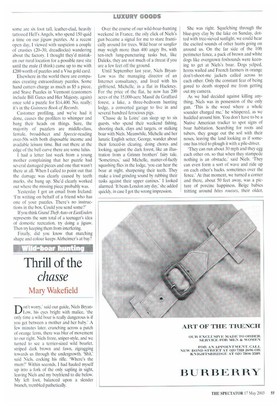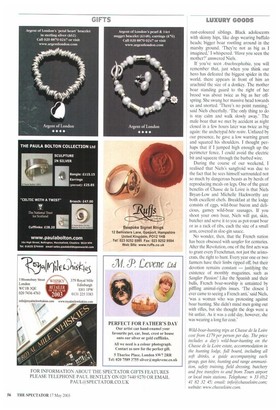Thrill of the chasse
Mary Wakefield
1—% on't worry,' said our guide, Niels Bryan1.1 Low, his eyes bright with malice, 'the only time a wild boar is really dangerous is if you get between a mother and her baby.' A few minutes later, crunching across a patch of orange ferns, there was blur of movement to our right. Niels froze, sniper-style, and we turned to see a terrier-sized wild boarlet, striped dark brown and fawn, zigzagging towards us through the undergrowth. 'Shit,' said Niels, cocking his rifle. 'Where's the mum?' Within seconds, I had hauled myself up into a fork of the only sapling in sight, leaving Niels and my boyfriend to die below. My left foot, balanced upon a slender branch, trembled pathetically. Over the course of our wild-boar-hunting weekend in France, the oily click of Niels's gun became a signal for me to stare frantically around for trees. Wild boar or sanglier may weigh more than 400 angry lbs, with ten-inch lung-puncturing tusks but, like Daleks, they are not much of a threat if you are a few feet off the ground.
Until September last year, Niels BryanLow was the managing director of an Internet consultancy, and lived with his girlfriend. Michelle, in a flat in Hackney. For the price of the flat, he now has 200 acres of the 15,000-acre Massif du Graffard forest, a lake, a three-bedroom hunting lodge, a converted garage to live in and several hundred ferocious pigs.
'Chasse de la Loire' can sleep up to six guests, who spend their weekend fishing, shooting duck, clays and targets, or stalking boar with Niels. Meanwhile, Michelle and her lunatic English setter, George, wander about their fenced-in clearing, doing chores and looking, against the dark forest, like an illustration from a Grimm brothers' fairy tale. 'Sometimes,' said Michelle, matter-of-factly squashing flies in the lodge, 'you can hear the boar at night, sharpening their teeth. They make a loud grinding sound by rubbing their tusks against their upper canines.' I looked alarmed. 'It beats London any day,' she added quickly, in case I got the wrong impression. She was right. Squelching through the blue-grey clay by the lake on Sunday, dotted with tree-sieved sunlight, we could hear the excited sounds of other hunts going on around us. On the far side of the 10ft perimeter fence, a pack of brown and white dogs like overgrown foxhounds were keening to get at Niels's boar. Dogs yelped, horns wailed and French farmers in orange don't-shoot-me jackets called across to each other. Only the constant fear of being gored to death stopped me from getting out my camera.
As we had decided against killing anything, Niels was in possession of the only gun. 'This is the wood where a whole sounder charged me: he whispered, as we huddled around him. You don't have to be a Native American tracker to spot signs of boar habitation. Searching for roots and tubers, they gouge out the soil with their noses, leaving the land looking as if someone has tried to plough it with a pile-driver.
'They can run about 30 mph and they egg each other on, so that when they stampede nothing is an obstacle,' said Niels. 'They can even form a sort of wave and ride up on each other's backs, sometimes over the fence.' At that moment, we turned a corner and there, about 50 feet away, was a picture of porcine happiness. Beige babies tritting around betes rousses, their older, rust-coloured siblings. Black adolescents with skinny hips, like dogs wearing buffalo heads; bigger boar rootling around in the marshy ground. 'They're not as big as I imagined,' I whispered. 'Have you seen the mother?' answered Niels.
If you've seen Arachnophobia, you will remember that, just when you think our hero has defeated the biggest spider in the world, there appears in front of him an arachnid the size of a donkey. The mother boar standing guard to the right of her brood was about twice as big as her offspring. She swung her massive head towards us and snorted. 'There's no point running,' said Niels cheerfully. 'The only thing to do is stay calm and walk slowly away.' The male boar that we met by accident as night closed in a few hours later was twice as big again: the archetypal bête noire. Unfazed by our presence, he gave a low warning grunt and squared his shoulders. I thought perhaps that if I jumped high enough up the perimeter fence. I could avoid the electric bit and squeeze through the barbed wire.
During the course of our weekend, I realised that Niels's sangfroid was due to the fact that he sees himself surrounded not so much by dangerous beasts as by herds of reproducing meals on legs. One of the great benefits of Chasse de la Loire is that Niels Bryan-Low and Michelle Hackworthy are both excellent chefs. Breakfast at the lodge consists of eggs, wild-boar bacon and delicious, gamey wild-boar sausages. If you shoot your own boar, Niels will gut, skin, butcher and serve it to you as pot-roast boar or as a rack of ribs, each the size of a small arm, covered in sloe-gin sauce.
No wonder, then, that the French nation has been obsessed with sanglier for centuries. After the Revolution, one of the first acts was to grant every Frenchman, not just the aristocrats, the right to hunt. Every year one or two farmers have their limbs ripped off, but their devotion remains constant — justifying the existence of monthly magazines, such as Sanglier Passion! Like the Spanish and their bulls, French boar-worship is untainted by piffling animal-rights issues. 'The closest I ever came to seeing a French anti,' said Niels, 'was a woman who was protesting against boar hunting. She didn't mind men going out with rifles, but she thought the dogs were a bit unfair. As it was a cold day, however, she was wearing a long fur coat.'
Wild-boar-hunting trips at Chasse de la Loire cost from £179 per person per day. The price includes a day's wild-boar-hunting on the Chasse de la Loire estate, accommodation in the hunting lodge, full board, including all soft drinks, a guide accompanying each group, gun hire, hunting and range ammunition, safety training, field dressing, butchery and free transfers to and from Tours airport or local train stations. Telephone: + 33 (0)2 41 82 32 45; email: info@chasseloire.com; website: www.chasseloire.com.



































































































 Previous page
Previous page